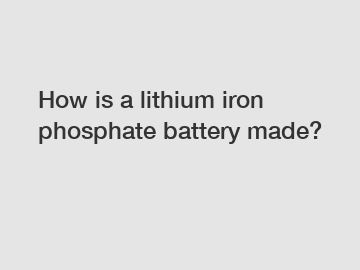How is a lithium iron phosphate battery made?
How is a lithium iron phosphate battery made?
Lithium iron phosphate (LiFePO4) batteries have gained popularity in recent years due to their exceptional energy density, long cycle life, and improved safety features compared to other lithium-ion battery chemistries. They are being extensively used in a variety of applications, including electric vehicles, renewable energy storage systems, and portable electronics. But how are these batteries made? Let's delve deeper into the production process to understand how a lithium iron phosphate battery is manufactured.
1. Raw Materials:

The first step in manufacturing a lithium iron phosphate battery involves gathering the necessary raw materials. The key components needed for the battery include lithium iron phosphate powder, conductive additives, a polymer binder, and a current collector. These materials should be of high quality to ensure the battery's performance and longevity.
2. Electrode Preparation:
Once the raw materials are assembled, the next step is to prepare the electrodes. Firstly, the active material, which is the lithium iron phosphate, is mixed with conductive additives and a binder. This mixture is then coated onto a current collector, generally made of aluminum for the cathode and copper for the anode. The coated current collectors are then dried to remove any remaining solvents, resulting in electrode sheets.
3. Cell Assembly:
The electrode sheets are further processed by pressing them onto a separator material, commonly made of porous polyethylene or polypropylene. The separator acts as an insulator between the anode and cathode, preventing short circuits while allowing the flow of lithium ions. After the electrodes and separator are assembled, they are rolled or stacked to form a jellyroll-like structure.
4. Electrolyte Filling:
The jellyroll structure is then inserted into a battery casing, which is typically made of aluminum or stainless steel. The next step involves filling the casing with an electrolyte solution. The electrolyte facilitates the movement of lithium ions between the anode and cathode during charging and discharging. The correct amount of electrolyte is essential to ensure optimal battery performance.
5. Sealing and Formation:
Once the electrolyte is filled, the battery casing is sealed to prevent leakage or contamination. Subsequently, a formation process takes place, which involves applying a precise current and voltage to the battery for a specific duration. This process activates the battery and enhances its initial performance. It is crucial to strictly follow the recommended formation procedure to achieve optimal battery capacity and longevity.
6. Aging and Testing:
After formation, the batteries undergo an aging process to stabilize their performance. This typically involves storing the batteries at a specific temperature for a predetermined period. Following aging, comprehensive testing is conducted to verify the battery's capacity, voltage, and other performance parameters. These quality checks ensure that only batteries meeting the specified criteria are released for use.
In conclusion, the production of lithium iron phosphate batteries involves several stages, starting from material preparation and electrode coating, followed by cell assembly, electrolyte filling, sealing, formation, aging, and final testing. Each step requires meticulous attention to detail to achieve high-quality batteries with desirable performance characteristics. As technology advancements continue, we can expect further refinements in the manufacturing processes, leading to even better lithium iron phosphate batteries that play a vital role in the transition to a greener and sustainable future.
The company is the world’s best lithium iron phosphate battery manufacturers china, 3.2v lifepo4 cells, 280ah Lifepo4 Battery supplier. We are your one-stop shop for all needs. Our staff are highly-specialized and will help you find the product you need.
172
0
0


Comments
All Comments (0)